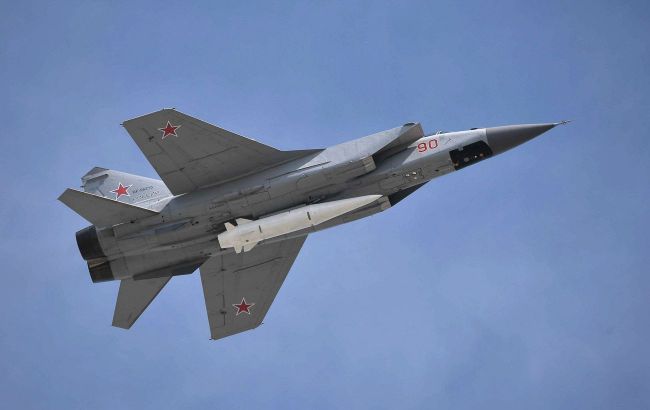Kinzhals in the air: What explosions occurred in Kyiv and why Russia again uses MiGs for strikes
 Photo: In Ukraine, one air raid alert after another due to the launch of Kinzhals from MiG-31K (Wikipedia)
Photo: In Ukraine, one air raid alert after another due to the launch of Kinzhals from MiG-31K (Wikipedia)
Since this morning, a large-scale air raid alarm has been declared three times across Ukraine. The reason is the attack of Kinzhal missiles flying towards Starokostiantyniv in the Khmelnytskyi region. However, the characteristic sounds of explosions were heard in Kyiv and several other regions.
Why this happened and why Russia decided to actively use Kinzhals for strikes today is explained below by RBC-Ukraine.
Contents
- Why explosions were heard in Kyiv and several regions
- Why Russia again involved MiGs in strikes
- Why the air alert was not declared earlier during the first attack of the Kinzhals
The first two Kinzhals, launched from MiG-31K fighters, entered Ukrainian airspace around 10:00 AM. Explosions were heard in Kyiv, Chernihiv, and Zhytomyr regions. The attack was repeated around 10:50 AM (Kyiv time).
The third air raid alert, again due to the takeoff of MiG-31K, was declared at 11:36 AM, but no consequences were reported. There were no missile launches, and the alert was lifted at 12:11 PM (Kyiv time).
Later, Ukraine's Air Force confirmed that Russia launched three Kinzhal hypersonic missiles towards Starokostiantyniv in the Khmelnytskyi region, where a military airfield is located.
"From 10:00 AM to 11:00 AM (Kyiv time), three Kh-47 M2 Kinzhal aeroballistic missiles were launched from Russian airspace towards Starokostiantyniv in the Khmelnytskyi region. According to preliminary data, there were four MiG-31K fighter jets in Russian airspace," the military reported.
They also stated that information about missile strikes or damage is not public.
Meanwhile, Kyiv's military administration clarified that the capital's air defense was not activated, and the city was not under attack. They emphasized that the term "explosions" used by media and Telegram channels was misleading, as the sounds could have been caused by physical phenomena such as breaking the sound barrier.
"Actually, the term 'explosion' during wartime is primarily associated with the enemy's use of powerful weapons, military exercises, the disposal of explosive objects, etc. Sometimes, an explosion can be technological (for example, gas). But, in addition to this, there are physical phenomena such as thunder or the breaking of the sound barrier by an aircraft/rocket,” wrote the head of the Kyiv City Military Administration, Serhii Popko.
In his opinion, messages like “explosions in Kyiv” are “disinformation” that has “sowed panic among the population.”
“People may perceive such information, for example, as a result of a missile strike on the capital. However, in reality, the capital’s air defense was not operational, the enemy's missile weaponry was not used over the territory of Kyiv, and there were no other military factors that could have caused the 'explosion,'” Popko asserts.
Why explosions were heard in Kyiv and several regions
Monitoring channels reported that the sounds of explosions in various regions, which coincided with the trajectory of the Kinzhal missiles, were the sounds of breaking the sound barrier.
“The rocket travels at nearly hypersonic speed during the final stage; therefore, along its flight path - usually in the Chernihiv, Kyiv, Zhytomyr, Vinnytsia, and Khmelnytskyi regions - loud sounds can be heard,” wrote the Telegram channel “yeRadar.”
Aviation expert and leading researcher at the National Aviation University (NAU) Valerii Romanenko believes this is somewhat exaggerated. Here’s why.
“The Kinzhal follows a ballistic trajectory, the majority of which is at an altitude of 30-40-50 km. An explosion can only be heard in the vicinity of its impact. For instance, an explosion can be heard when the rocket descends towards the target. But it is not the case that there are explosions all along its flight path,” Romanenko explained in a comment to RBC-Ukraine.
According to him, these sounds were likely the work of air defense systems, which include missile launches and fighter jets breaking the sound barrier.
Meanwhile, the Kyiv City Military Administration stated whether the breaking of the sound barrier by the aerial ballistic missile Kinzhal during its flight over Kyiv was another physical phenomenon - specialists competent in this matter will provide an answer.
Why Russia again involved MiGs in strikes
Notably, until now, the Russians usually employed Kinzhal missiles during massive combined attacks on Ukraine. However, today was different. Experts note that the enemy is now placing an emphasis specifically on ballistic missiles.
“Why? Because we have very few anti-ballistic systems. We have a more or less adequate number of conventional anti-aircraft systems. We have also received IRIS-T, NASAMS, and older Soviet systems are still operational. FrankenSAM has also been re-equipped. Therefore, cruise missiles are vulnerable, but most of Ukraine lacks protection against ballistic missiles,” Romanenko stated.
Thus, according to him, the aggressor is currently focusing on striking Ukrainian infrastructure using ballistic missiles.
Iskanders, where they can reach, have a relatively short range - 500 km. The Kinzhal has a range of up to 1000 km. This is because they do not expend fuel on climbing to altitude; they are lifted by a fighter jet and launched from a high altitude at high supersonic speed. Therefore, this effectively doubles their flight range,” emphasized Romanenko.
Why the air alert was not declared earlier during the first attack of the Kinzhals
It should be noted that during the first attack, explosions were heard almost simultaneously, and air raid alerts spread across the regions. The sounds were heard not only in the capital but also in several other regions.
This raises the question of why the danger was not announced in advance. Currently, the Air Force has not commented on why this happened. However, an aviation expert has suggested a possible reason.
“It’s hard to say. This is more of a question for the Air Force spokesperson. They might have thought that the MiGs were conducting another training flight. However, generally, when MiGs take off from Mozdok, Akhtuba, or Savasleyka, they can be seen practically after takeoff and climbing to an altitude of about 3-4 thousand meters from 1200 km away,” Romanenko explains.
He speculates that the missile launches were probably from atypical launch zones. Launches generally occur either from the waters of the Black Sea (if taking off from Mozdok), from the Caspian Sea (if taking off from Ahtuba), or from the Ryazan region (if taking off from Savasleyka).
“Perhaps the circumstances indicated this was a regular training flight,” Romanenko concluded.
That night, the Russian militants attacked Ukraine once again. In particular, they launched two rockets of an unspecified type at the Sumy region and four Kh-59/69 missiles at the Odesa region. The occupiers also used 78 Shahed drones.
However, the air defense forces managed to shoot down four Kh-59/69 missiles and 66 drones. Another 8 drones were lost in several regions of Ukraine.
Nevertheless, there were consequences. In particular, debris fell in the Pechersk district of Kyiv, injuring two people. In Ivano-Frankivsk, a critical infrastructure facility was damaged, leaving some of the city without power. Additionally, the Russian Federation terrorized Zaporizhzhia with kamikaze drones, injuring 10 people.
For more information on the nighttime attack on Ukraine and its consequences, read the material by RBC-Ukraine.
Sources: the Air Forces’ Telegram channel, data from the monitoring group “eRadar,” KMVA, and exclusive comments from aviation expert and leading researcher at the National Aviation University (NAU) Valerii Romanenko.

